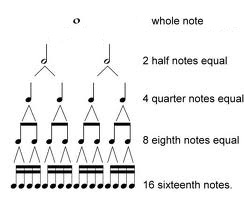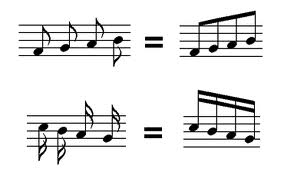Lesson 2
Notes and Their Values
Notes last for a certain duration of time depending on what kind of note it is. We are going to look at a few examples of notes to get us started. Below are the notes that we are going to explore in this lesson.
Here are the most commonly used notes in music. The first one is a whole note. We will get into time signatures later. For now, just know that a whole note takes up a whole measure of time. In our last lesson we learned what a measure is. If there is ever a whole note in a measure, there won’t be any other notes in that same measure. Until I can teach you more, this may seem a little tricky, but it’s quite simple once you understand time signatures. We will get into that in Lesson 3.
Below is a picture of the notes again showing their relationship to each other.

The half note is equal to two (2) quarter notes. The quarter note is equal to two (2) eighth notes. The eighth note is equal to two (2) sixteenth notes. So the notes actually split in half each time. And in reverse; two sixteenth notes equal an eighth note, two eighth notes equal a quarter note, and two quarter notes equal a half note.
Note: Two half notes may or may not equal a whole note. This is completely dependent on what the time signature is.
All notes above a quarter note has flags in them. Below shows a diagram of the parts of a note.

Each time the notes duration of time is cut in half, it gets another flag. The flags can be on a single stem or connecting two or more note stems. Below are some examples of eighth notes and sixteenth notes on a staff. Both the left and right are equal to each other. Just the flags are made differently, but both sides has four notes. Eighth notes on the top and sixteenth notes on the bottom.

Notes (theoretically) can be split in half indefinitely. And each division adds a flag. But let’s stay with these for now. This is enough to learn how things work.
This concludes Lesson 2. I hope you found it to be informative. You should review it and know it. Then go on to Lesson 3. I hope that you understand everything alright. If you have any questions, feel free to ask and I will try to explain it better.
Take Care,
mark





